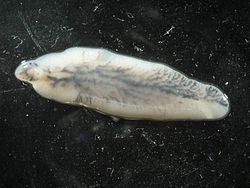Top Qs
Timeline
Chat
Perspective
Fasciolidae
Family of flukes From Wikipedia, the free encyclopedia
Remove ads
Fasciolidae is a family of trematodes and includes several parasites involved in the veterinary and medical sciences, which cause the disease Fasciolosis. Fasciolidae is divided into five genera by Olson et al. 2003. The family's various species are localised in liver, gall bladder, and intestine. Their life-cycle includes an intermediate host, freshwater snails from the family Lymnaeidae.[1]
Remove ads
Morphology
Adult trematodes of Fasciolidae range in length from 2 cm, for species of Parafasciolopsis, and 10 cm, for species such as Fasciola gigantica. The oral and ventral suckers are usually located. the cercariae are of a gymnocephalic shape.[2]
Systematics within family
According to Olson et al. 2003 [3] the family has five genera:
- Fasciola
- Fasciola hepatica – Common liver fluke
- Fasciola gigantica
- Fasciola spp. – Japanese strain
- Fascioloides
- Fascioloides magna
- Fascioloides jacksoni
- Fasciolopsis
- Parafasciolopsis
- Parafasciolopsis fasciolaemorpha
- Protofasciola
- Protofasciola robusta
References
Wikiwand - on
Seamless Wikipedia browsing. On steroids.
Remove ads

